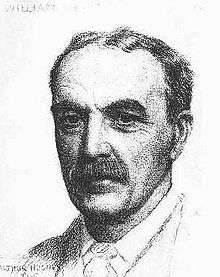Hale White

William Hale White (22 December 1831 – 14 March 1913), known by his pseudonym Mark Rutherford, was a British writer and civil servant.
Life, career and memorials
White was born in Bedford. His father, William White, a member of the Nonconformist community of the Bunyan Meeting, became well known as a doorkeeper at the House of Commons and wrote sketches of parliamentary life for the Illustrated Times.[1] A selection of his parliamentary sketches was published posthumously, in 1897, by Justin McCarthy, the Irish nationalist MP, as The Inner Life of the House of Commons.[2]
White himself was educated at Bedford Modern School[3] until the family moved to London.[4] There he was trained for the Congregational ministry, but the development of his views prevented his taking up that career; the same unconventional views got him expelled from New College, London,[5] and he eventually became a clerk at the Admiralty.[4] In 1861 he began writing newspaper articles to increase his income, having met and married Harriet Arthur and started a family.[5]
He had already served an apprenticeship to journalism before he made his name, or rather his pen name, "Mark Rutherford", famous with three novels, supposedly edited by one Reuben Shapcott: The Autobiography of Mark Rutherford (1881), Mark Rutherford's Deliverance (1885) and The Revolution in Tanner's Lane (1887).[6][7]
Under his own name White translated Spinoza's Ethics (1883). His later books include Miriam's Schooling, and Other Papers (1890), Catherine Furze (2 vols, 1893), Clara Hopgood (1896), Pages from a Journal, with Other Papers (1900), and John Bunyan (1905).[7]
There is now a Mark Rutherford School in Bedford and a blue plaque commemorates White at 19 Park Hill in Carshalton.[8]
Family
White's first wife, Harriet, died in 1891 of multiple sclerosis. Two of their children had died in infancy.[5] In 1907, the widowed White met aspiring novelist Dorothy Smith, who was forty-five years his junior. They fell in love and were married three and a half years later, but only enjoyed two years of married life before his death.[9]
His eldest son by his first wife, Sir William Hale-White, was a distinguished doctor (sketch). His second son, Jack, married Agnes Hughes, one of Arthur Hughes' daughters. A third son became an engineer, and White's daughter Molly remained at home to care for her father.[5]
Selected publications
- The Autobiography of Mark Rutherford: Dissenting Minister Trubner and Co., London, 1881
- Mark Rutherford's Deliverance Trubner and Co., London, 1885
- The Revolution in Tanner's Lane Trubner and Co., London, 1887
- Miriam's Schooling Kegan Paul, Trench, Trubner and Co., London, 1890
- Catharine Furze T. Fisher Unwin, London, 1893
- Clara Hopgood T. Fisher Unwin, London, 1896
Notes
- ↑ "Dictionary of Nineteenth-century Journalism in Great Britain and Ireland". google.co.uk. Retrieved 12 July 2015.
- ↑ William White, The Inner Life of the House of Commons, edited with a preface by Justin McCarthy, MP, London, T. Fisher Unwin, 1897
- ↑ "Bedford Modern School of the black & red". worldcat.org. Retrieved 12 July 2015.
- 1 2 Bedford Borough Council and Central Bedfordshire Council. "Mark Rutherford (William Hale White) - Digitised Resources - The Virtual Library". culturalservices.net. Retrieved 12 July 2015.
- 1 2 3 4 Michael Brealey (2014-07-08). Bedford's Victorian Pilgrim: William Hale White in Context. Authentic Publishers. pp. 20–. ISBN 978-1-78078-351-2.
- ↑ Max Saunders, "Autobiografiction," Times Literary Supplement (3 October 2008), 13-15.
- 1 2 "Results for 'au:Rutherford, Mark,' [WorldCat.org]". worldcat.org. Retrieved 12 July 2015.
- ↑ "WHITE, WILLIAM HALE (1831–1913)". English Heritage. Retrieved 2012-08-05.
- ↑ "Obituary of Dorothy Vernon Horace Smith, The Times". 28 August 1967. Retrieved 28 May 2016.
References
 This article incorporates text from a publication now in the public domain: Chisholm, Hugh, ed. (1911). "article name needed". Encyclopædia Britannica (11th ed.). Cambridge University Press.
This article incorporates text from a publication now in the public domain: Chisholm, Hugh, ed. (1911). "article name needed". Encyclopædia Britannica (11th ed.). Cambridge University Press.- William James Dawson, "Religion in Fiction", a chapter, part of which is devoted to Hale White (on p. 283-289) in The Makers of English Fiction, 2nd ed., F.H. Revell Co., 1905.
- E. J. Feuchtwanger, White, William (1807–1882), Oxford Dictionary of National Biography, Oxford University Press, 2004.
- Cunningham, Valentine. "White, (William) Hale (1831–1913)". Oxford Dictionary of National Biography (online ed.). Oxford University Press. doi:10.1093/ref:odnb/36864. (Subscription or UK public library membership required.)
External links
- Works by Hale White at Project Gutenberg
- Works by or about Mark Rutherford at Internet Archive
- Works by or about Hale White at Internet Archive
- Works by Hale White at LibriVox (public domain audiobooks)

- Mark Rutherford Resource